The mandatory Vehicle Entry Permit (VEP) system began with a soft enforcement in October 2024. All Singapore-registered vehicles entering Malaysia via land checkpoints must have a valid VEP.
From 1 July 2025, full enforcement will begin. If found without a valid VEP, drivers of non-Malaysian-registered vehicles will receive a compound fine of RM300 (S$91).
This guide covers every aspect of the VEP process, from initial application to practical usage tips, helping you navigate this new requirement with confidence.
Understanding the Vehicle Entry Permit (VEP)
The Vehicle Entry Permit (VEP) is a mandatory digital authorization system implemented by Malaysia’s Road Transport Department (JPJ) under Section 66H of the Road Transport Act 1987.
This system helps Malaysian authorities track foreign vehicles entering the country, ensures proper documentation and insurance coverage, and facilitates the collection of road charges from foreign vehicle users.
The VEP system is fundamentally different from traditional paper permits or stickers, operating through Radio Frequency Identification (RFID) technology, with each vehicle receiving a unique RFID tag that contains the vehicle’s registration information and permit details.
This tag must be properly installed on the vehicle’s windscreen and remains valid for five years from the date of issuance.
All foreign-registered vehicles, including those from Singapore, must obtain a VEP before entering Malaysia.
This requirement applies regardless of the duration of stay, purpose of visit, or frequency of travel, with very limited exemptions, primarily for diplomatic vehicles and certain emergency services.
The immediate penalty for traveling without a valid VEP is a RM300 compound fine that must be paid before the vehicle is allowed to leave Malaysia.
What do you need before applying for a VEP
You will need to prepare several documents on hand before applying:
- Your vehicle registration certificate – which can be downloaded from One Motoring – containing details of your vehicle
- Motor insurance details (e.g., policy number, provider, expiry date)
- Identification document (e.g., NRIC)
The Vehicle Registration Certificate must be current and match exactly with the information you provide in your VEP application.
Make sure that that all vehicle details, including the chassis number, engine number, and registration number, are accurately transcribed
Insurance coverage represents one of the most complex aspects of VEP preparation. Your vehicle insurance must explicitly cover cross-border travel to Malaysia.
Standard Singapore vehicle insurance policies often exclude coverage outside Singapore, so you’ll need to either upgrade your existing policy or purchase additional coverage specifically for Malaysian travel.
The insurance certificate must clearly state that coverage extends to Malaysia, and this coverage must remain valid throughout your VEP’s validity period.
Step-by-Step VEP Application Process
The VEP application process is entirely online, conducted through Malaysia’s official VEP portal at https://vep.jpj.gov.my.
Sign up for an account on the portal, and be sure to use only this portal as the authorized platform for VEP applications.
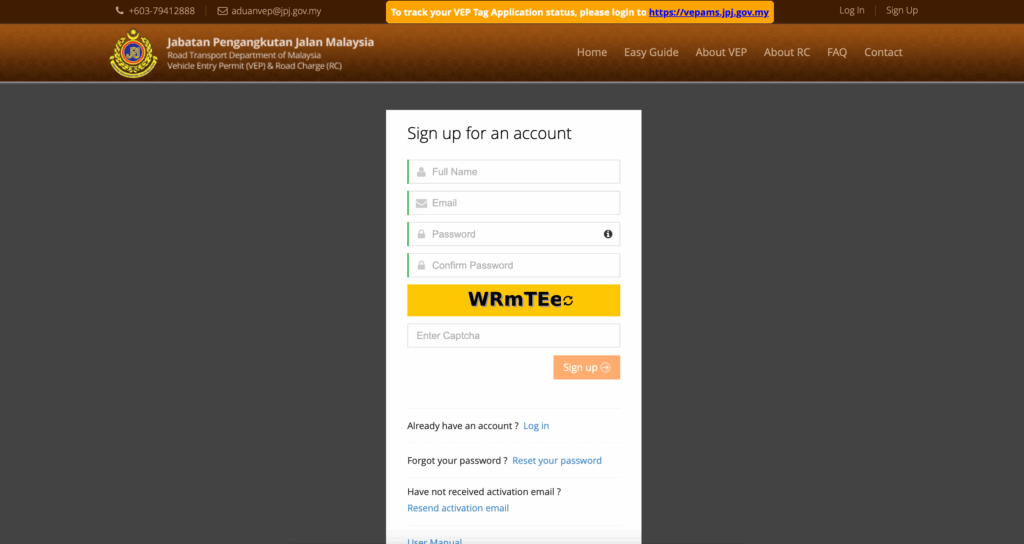
You also have to download the Touch N’ Go app before applying for the VEP.
When creating an account, you’ll need to provide personal information that matches exactly with your identification documents. This means you have to use the same name format, spelling, and details that appear on your official documents.
Once your account is established, the application form requires comprehensive vehicle and owner information.
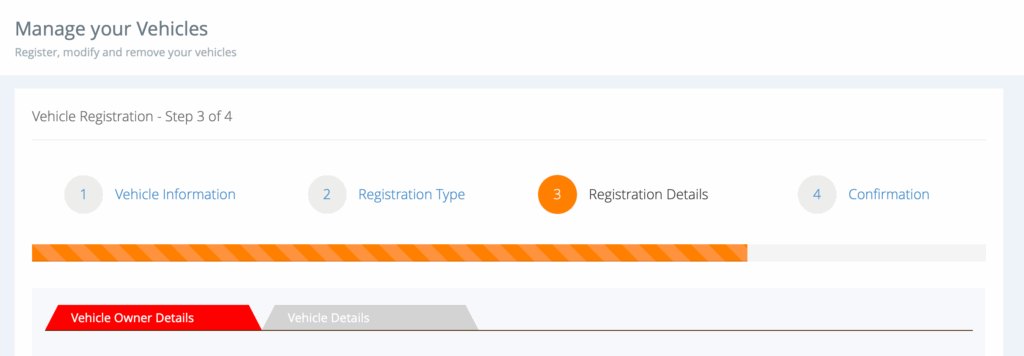
Enter your vehicle registration number exactly as it appears on your registration certificate, including any letters and numbers in the precise format shown.
The chassis number and engine number must also match your registration documents exactly. Any discrepancies will result in application rejection and require you to start the process over.
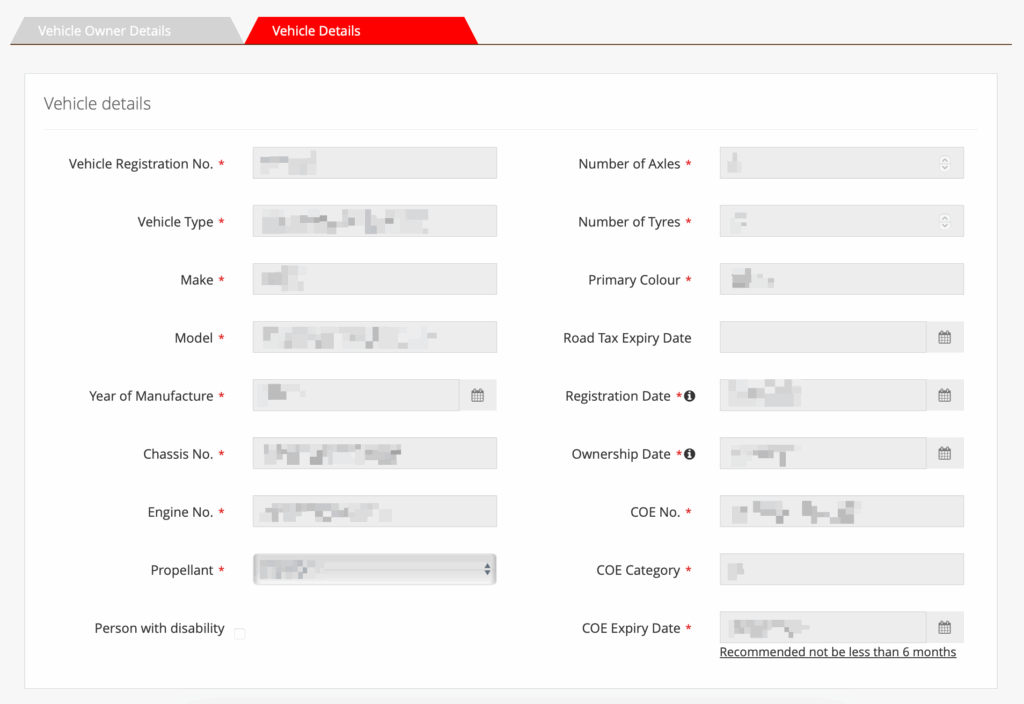
During the application process, you’ll also be required to upload documents such as your motor insurance, identification documents and car information.
Avoid shadows, glare, or blur that might obscure important information. The system typically accepts JPEG and PNG formats, with file size limits that vary depending on the document type.
VEP verification process
Once you have submitted your documents and furnished your information online, the verification process can take anywhere from a few days to several weeks, depending on the volume of applications and the completeness of your submission.
In our experience, it took 2-3 business days for verification – our first attempt got rejected due to full name mismatch.
During this period, you can track your application status using the VEP Application Management System, which provides real-time updates on your application progress and will notify you of any additional requirements or issues that need attention.
Once the registration process is completed, you will need to visit the VEP Application Management System to make payment and select the VEP RFID tag collection options.
The payment process includes a processing fee and the cost of the RFID tag itself, typically totaling around RM50-60.
If your application is rejected or requires additional information, address the issues promptly and completely. Partial corrections or inadequate responses will result in further delays.
VEP RFID Tag Collection
Once your VEP application is approved and payment is processed, you’ll need to obtain the physical RFID tag that serves as your vehicle’s entry permit.
You have two collection options:
- Self-Collection at VEP centers in Johor Bahru
- Delivery to your address in Singapore or Malaysia, which costs RM30 for service and RM15 for postage
Self-collection at the VEP Tag Collection Center offers the advantage of immediate availability once you receive approval notification.
VEP self-collection option
The primary collection center is located at TCSens VEP Collection Centre, located at:
- G Floor, Block 6, Danga Bay, Jalan Skudai, 80200 Johor Bahru (9am to 5pm, Wed-Sun)
There are also alternative venues that can be used as collection points:
- Paradigm Mall, Carpark Level 7, Skudai Highway, 81200 Johor Bahru (10am to 10pm daily)
- Sunway Big Box, West Wing’s lower ground carpark, Persiaran Medini 6, Sunway City, 79250 Iskandar Puteri (10am-9pm daily)
- MY VEP Pte Ltd, 186 Woodlands Industrial Park E5, #03-01, Singapore 757515 (9am-5pm, Mon-Fri)
When visiting the collection center for self-collection, bring your approval notification email which can be printed or on your mobile device), the original identification document used in your application (NRIC or passport), and your vehicle registration certificate.
The collection process typically takes 15-30 minutes, during which staff will verify your identity and provide instructions for proper RFID tag installation.
VEP home delivery option
Delivery to Singapore addresses is available if you prefer not to make a special trip to Johor Bahru solely for tag collection.
Delivery typically takes 5-10 business days from the time of order placement, and in our experience, takes about 10 days from the time you submit. Once you received the VEP tag, it’s time to install it on your vehicle.
How to install the VEP tag on your vehicle
If you choose home delivery, you will receive the VEP kit and instructions on how to install it.
The first step is acknowledging you have received your tag, by going back to the VEP Application Management System, login and click the Acknowledgment button after selecting your vehicle.
Once done, verify your VEP tag by entering the serial number of the VEP bar code.
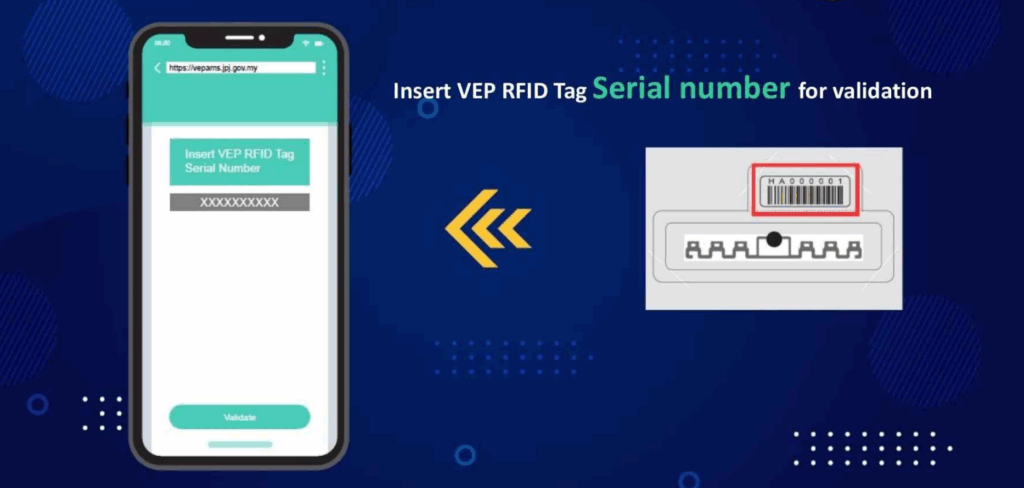
VEP fitment process
Once acknowledged, you can fit your VEP on the car’s left headlamp.

Keep the installation are clean and dry, by first wiping it with alcohol swaps or a gentle wet tissue and drying it. Then, affix the tag horizontally on the passenger side headlamp, ensuring it is at least 5cm from any metal frames.
The RFID tag contains sensitive electronic components that can be damaged by heat, moisture, or physical impact. Handle the tag carefully during installation and avoid touching the electronic components directly.
Once installed, the tag should not be removed or repositioned, as this can damage its functionality and may require you to obtain a replacement tag.
Submitting the VEP installation for activation
Finally, submit the tag for approval on the portal again with photo evidence of your successful installation on the headlamp – be sure to include your vehicle number and the VEP tag clearly.
Activation of the VEP takes 3-5 business days, and in our experience, was done on the same day within 8 hours.
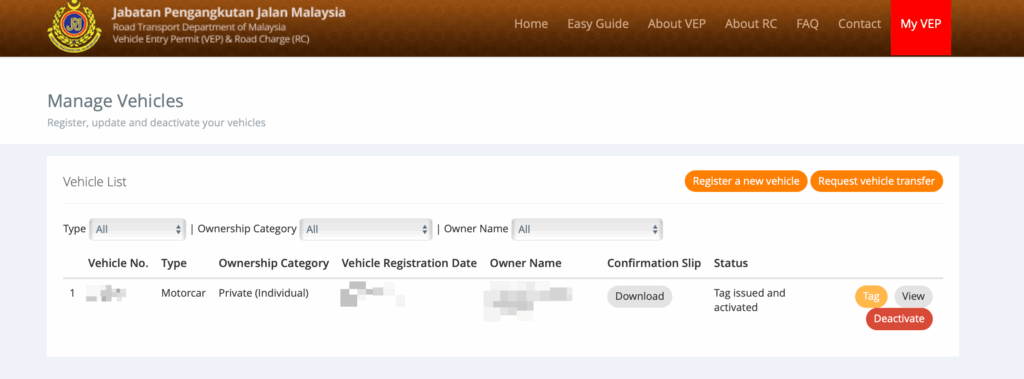
Road Charge (RC) with your VEP
The road charge is set at RM20 per entry into Malaysia, charged each time your vehicle crosses the border, which is in addition to any tolls you’ll pay while driving on Malaysian highways.
The way you pay for the road charge is through your VEP RFID tag, which is linked to your Touch N’ Go eWallet or other approved payment methods.
Ensure that you setup your Touch N’ Go eWallet with sufficient funds available for both road charges and potential toll payments during your journey.
Using Your VEP when traveling to Malaysia
With your VEP RFID tag properly installed, VEP-equipped vehicles typically use designated lanes at tolls and border checkpoints that can process RFID tags automatically.
These lanes are marked with VEP signage and electronic readers that detect your tag as you approach.
The system automatically verifies your VEP status, deducts the road charge, and records your entry into Malaysia.
You are also advised to still keep your TNG card with you, just in case you run into some issues with the RFID at toll booths, especially if technical issues such as RFID reading problems and system maintenance prevent your VEP tag from functioning properly at toll booths.
Renewing VEP
VEP RFID tags are valid for 5 years, which means that most of us won’t need to think about renewal immediately.
You will receive email notifications as your VEP expiry date approaches.
The renewal process is similar to the initial application, requiring updated documentation and verification of continued eligibility.
If your vehicle registration details change during the VEP validity period, you must update this information in your VEP account promptly. Changes include ownership transfer, address changes, or vehicle modifications.
If you damage your VEP tag, or lose it due to theft, initiate the process by sending an email to aduanvep@jpj.gov.my. The replacement process typically involves deregistering the damaged tag, applying for a new tag, and potentially paying replacement fees.
Tips for VEP application
Begin your VEP application well before you need to travel to Malaysia, as processing times can vary significantly depending on application volume and document completeness.
Allow at least 4-6 weeks for the entire process from initial application to tag collection and installation, though the process can sometimes be completed more quickly.
Store copies of your VEP approval, vehicle registration, insurance certificates, and payment receipts both in cloud storage and in your vehicle. This redundancy ensures you can access necessary information even if your primary copies are lost or damaged.
In terms of general feedback, Singapore drivers tend to highlight the importance of patience and preparation. While the initial setup process can be time-consuming and sometimes frustrating, the long-term benefits of faster border crossings and automated payment processing make the investment worthwhile.
Recent Updates on the VEP
The Malaysia government will commence enforcement of the Vehicle Entry Permit (VEP) requirement at the Malaysia-Singapore land borders. This will be effective from 1 July 2025. The country’s Ministry of Transport announced this on 4 June (Wednesday).
This enforcement date marks the end of a grace period. This period began in October 2024. During this time, violations resulted in warnings rather than penalties.
This enforcement timeline provides a clear deadline for all Singapore drivers who regularly travel to Malaysia. The grace period allowed many drivers to test the system and work through initial implementation issues, but the approaching enforcement date means that compliance is no longer optional.
Future developments in the VEP system may include integration with additional services, enhanced digital features, and potential expansion to other border crossings.
Malaysian authorities have indicated interest in using the VEP system as a foundation for broader digital border management initiatives, which could affect procedures and requirements in the coming years.
Singapore motorists with outstanding traffic fines in Malaysia will face enforcement action from Jan 1, 2025. From next year, drivers with unpaid fines may be denied entry to Malaysia and in extreme cases.
Frequently Asked Questions
Q: Can I apply for VEP after July 1, 2025?
A: Yes, you can still apply after the enforcement date, but you cannot enter Malaysia without a valid VEP after July 1, 2025, and will face penalties if you attempt to do so.
Q: What happens if my RFID tag stops working while I’m in Malaysia?
A: Contact aduanvep@jpj.gov.my immediately and be prepared to provide alternative documentation. You may need to pay fines manually and resolve the technical issue before leaving Malaysia.
Q: Do I need to renew my VEP if my vehicle registration expires and I renew it?
A: No, but you must update your VEP account with the new registration details to ensure system accuracy and avoid complications at border crossings.
Q: Can someone else collect my RFID tag for me?
A: Generally, tags must be collected by the applicant or vehicle owner. Check with JPJ for specific authorization procedures if you cannot collect personally.
Q: What if I sell my vehicle before the VEP expires?
A: You must transfer or cancel the VEP when selling your vehicle. The new owner will need to apply for their own VEP with updated ownership documentation.
Q: Are there different requirements for motorcycles versus cars?
A: The basic VEP requirements are the same, but installation procedures for RFID tags may differ. Motorcycle tags are typically smaller and have specific mounting requirements.
Q: Can I use the VEP system for multiple vehicles?
A: Each vehicle requires its own VEP and RFID tag. You can manage multiple vehicles under one account, but each needs separate applications and tags.
Q: What should I do if I’m denied entry despite having a valid VEP?
A: Ensure all your documents are current and your payment accounts have sufficient funds. If issues persist, contact JPJ customer service and consider consulting with Singapore authorities.
Q: How long does the RFID tag battery last?
A: RFID tags are passive devices that don’t require batteries. They draw power from the readers at checkpoints and toll booths, so there are no battery maintenance concerns.
Q: Can I remove and reinstall my RFID tag?
A: No, RFID tags are designed for permanent installation. Removing them typically damages the adhesive and may damage the electronic components, requiring replacement.
Leave a Reply